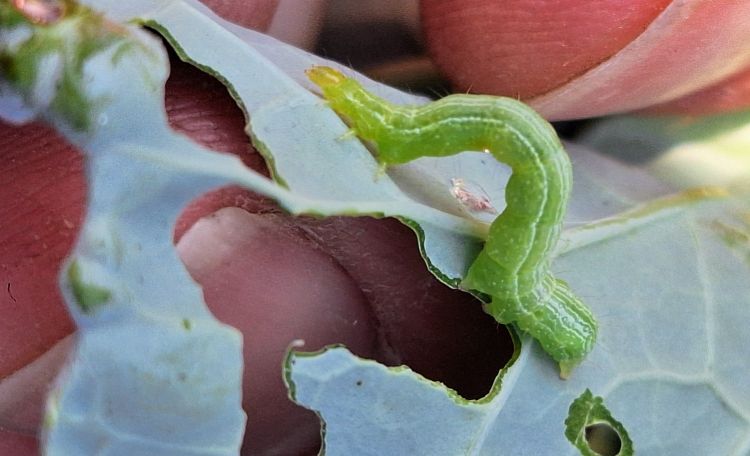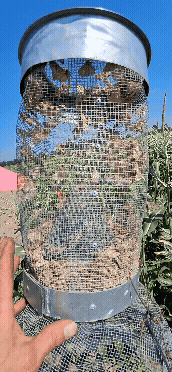Michigan vegetable crop report – August 20, 2025
Warm, dry weather increased crop growth but rainfall deficits remain. Asparagus rust is spreading, cucurbits face spider mites and mildew, cabbage looper is active in brassicas, and corn earworm pressure is high in west central sweet corn.

Weather
For the past week, temperatures were 1-6 degrees above-normal moving north to south with decent rains falling in dry parts of southwest and west central Michigan. Despite this, some areas still have very large rainfall deficits, on the order of a few months’ worth of rain. Soils are remarkably dry in central and southwest Michigan with other areas faring better. Degree day totals are one to two weeks ahead of normal given especially warm overnight temperatures.
This week’s forecast calls for:
- Decreasing cloudiness and cooler Wednesday, Aug. 21. Fair, cool and dry Thursday and Friday. Scattered showers possible overnight Friday and Saturday. Variably cloudy and cool Sunday through early next week.
- Precipitation totals of 0-0.5 inches. It will be a drier week.
- High temperatures from the low to mid -Wednesday, warming to the upper 70s to low 80s Friday and Saturday, then cooling to the upper 60s to low 70s by early next week. Lows generally in the 50s to low 60s through this weekend falling back to the 40s to low 50s by Monday.
- Medium range outlooks for the last week of August into early September call for cooler than normal mean temperatures and below normal rainfall totals.
Air quality
Check out this recent Michigan State University Extension article about considerations for farmers working in conditions of reduced air quality due to wildfire smoke:
Crop updates
Cucurbits
Between 10-13 disease severity values (DSVs) accumulated between Aug. 12-18 at five sensors Michigan State University Extension is monitoring in Oceana and Mason County asparagus. A fungicide application would have been indicated for Monday, Aug. 18, if nothing had been applied since Aug. 9-10 (assuming a 15 DSV interval).
Asparagus rust has been taking its toll in some asparagus fields. Experience has shown that even a good fungicide program may have difficulty slowing an epidemic once it has started. It can be especially challenging to manage this disease in young fields, which fern out when everyone is busy harvesting. Timely application of fungicides including tebuconazole, prior to extensive symptoms, is important. Scouting is also important, as it is not clear what environmental conditions favor this disease (there is no disease forecaster).
Cucurbits
Twospotted spider mites have been reported on cucumbers. Septoria has been found in squash. Powdery mildew has also been reported. Pumpkins are beginning to change color in southern Michigan.
Brassicas and greens
Cabbage looper caterpillars were present and frassin’ around with imported cabbage worm in unsprayed broccoli at our west central Michigan pest and disease demonstration garden. Cabbage looper is more of a late season pest. Caterpillars can get big and do a lot of damage if not controlled.
Carrots
Between 10-14 DSVs accumulated between Aug. 12-18 at two sensors Michigan State University Extension is monitoring in Oceana County carrots. A fungicide application would have been indicated for Monday, Aug. 18, if nothing had been applied since Aug. 9-10 (assuming a 15 DSV interval).
Onions and garlic
Some growers have reported smaller garlic bulbs and lower yields this year.
Oats can be a good option for a late season cover crop before planting garlic in the fall, depending on your goals and soil needs. As a cool season annual, oats establish quickly, suppress weeds and scavenge excess nutrients. Their fibrous roots help hold soil in place during cooler months, and the resulting biomass creates a mellow mulch for low or no till planting. The Sustainable Agriculture Research and Education program offers excellent resources on cover crops and their various types. Additionally, the Saginaw Valley Research and Extension Center is hosting a cover crop workshop if you are interested in learning more.
Sweet corn
Corn earworm numbers significantly increased in some parts of our trapping network, but not others, showing the value of having traps in different spots. A west central Michigan spike was reported by scouts the morning of Saturday, Aug. 9, and high to extremely high captures continued through this week at some west central Michigan locations. For wire Hartstack traps (at Ottawa and Oceana locations), a two-to-three-day spray interval could be considered as captures approach 50-100 per night. For cloth traps, two-to-three-day intervals may be warranted as captures approach or exceed 13 per night. These rules of thumb are adjusted by growers based on their customers’ tolerance for earworm and temperature (High temperatures make silks grow faster).

When pressure is high, highly effective products can be tapped in, including those containing chlorantraniliprole (Besiege, Coragen, Elevest, Exceliprole, Shenzi, Vantacor) or spinetoram (Radiant, Hemi, Intrepid Edge). Most selection for resistance likely happens in southern climes, so in Michigan rotation amongst modes of action is not as critical as for other pests. Choose what is effective and available and abide by label restrictions.
Table 1. Corn earworm captures. Total in trap for week1 (avg # per night2).
| Week | Saginaw Co.3 | Oceana Co.4 | Ottawa Co.4 | Monroe Co.3 | Genesee Co.3 | Lapeer Co.3 | Lapeer Co.3 |
|---|---|---|---|---|---|---|---|
| 30-Jun | - | 42 (7.0) | 265 (33.1) | - | - | - | - |
| 7-Jul | 3 (0.4) | 122 (17.4) | 30 (6.0) | - | - | - | - |
| 16-Jul | 6 (0.9) | 76 (10.9) | 4 (0.6) | 6 (0.86) | 2 (0.3) | 9 (1.3) | 2 (0.3) |
| 23-Jul | 0 (0.0) | 13 (1.9) | 1 (0.1) | - | 0 (0.0) | 0 (0.0) | 0 (0.0) |
| 30-Jul | 1 (0.1) | 4 (0.6) | 21 (4.2) | 0 (0.0) | 0 (0.0) | 0 (0.0) | 0 |
| 6-Aug | 0 (0.0) | 2 (0.3) | 4 (0.8)5 | 0 (0.0) | 0 (0.0) | 0 (0.0) | 0 (0.0) |
| 13-Aug | 1 (0.1) | 148 (16.4) | 789 (78.9) | 8 (1) | 52 (7.4) | 0 (0.0) | 4 (0.6) |
| 20-Aug | 11 (1.6) | 204 (40.8) | 730 (146.0) | - | 122 (17.4) | 0 (0.0) | 2 (0.3) |
1Total number collected since last trap check; 2The total number divided by the number of nights since the last trap check; 3Cloth Heliothis traps track trends but catch less moths overall; 4Wire Harstack traps capture more moths. 5Trap fell over so catches may be low.
To our south, many locations also showed a big spike on Aug. 11 in the trapping network maintained by Purdue University .Insect Forecast predicts little to no risk of additional migration through Aug 20. This coincides with a switch to more northerly airflow.
Western bean cutworm numbers declined in our trapping network as this pest finishes its season. To our south, Ohio State University is now monitoring for fall armyworm.
Table 2. Western bean cutworm captures. Total in trap for week1 (avg # per night2).
|
Week |
Genesee Co. |
Oceana Co. |
Ottawa Co. |
|---|---|---|---|
|
6/30 |
- |
0 (0.0) |
16 (2.0) |
|
7/7 |
- |
13 (1.8) |
17 (3.4) |
|
7/16 |
2 (0.3) |
54 (7.7) |
67 (9.6) |
|
7/23 |
6 (0.86) |
68 ( 9.7) |
316 (35.1) |
|
7/30 |
4 (0.6) |
95 (13.6) |
70 (14.0) |
|
8/6 |
1 (0.1) |
20 (0.3) |
51 (10.2) |
|
8/13 |
4 (0.6) |
19 (2.1) |
13 (1.3) |
|
8/20 |
2 (0.3) |
4 (0.8) |
5 (1.0) |
1Total number collected since last trap check; 2The total number divided by the number of nights since the last trap check.
Produce Food Safety On-Farm Readiness Reviews
Schedule an On-Farm Readiness Review today for a two-hour educational visit that takes place during the harvest season and is meant to be casual and low stress. Everything discussed during an On-Farm Readiness Review is confidential and focuses on ways to reduce risks in relation to produce safety. There is no pressure to take our advice either, we are just here to support you in your produce safety efforts.
On-farm soil moisture monitoring research opportunity
MSU researchers are looking for 20 farms to install soil moisture probes in up to two fields. Cooperators get access to real-time data for both monitoring stations for three growing seasons (fall 2025-fall 2028). Refer to the flier for more details.
Reach out to Alex Kuhl (kuhlalex@msu.edu) if you might be interested or have questions.
Events
- August 26, 12-1 p.m., Seed Treatment Webinar Series
- September 4, 5-8 p.m., Cover Crop Workshop at the Saginaw Research and Extension Center
- October 11, 1-3 p.m., Farm Field Day with Fisheye Farm
- October 21, 12-1 p.m., What are Your Farm Certification Goals? - TOPP Online Webinar
- October 28, 12-1 p.m., Organic Market Premium - How Much Can I Expect to Get for My Products? - TOPP Online Webinar
- November 4, 12-1 p.m., How to Make Money in Organic Farming - TOPP Online Webinar
- December 9-11, Great Lakes Expo
This work is supported by the Crop Protection and Pest Management Program [grant no 2024-70006-43569] from the USDA National Institute of Food and Agriculture. Any opinions, findings, conclusions, or recommendations expressed in this publication are those of the author(s) and do not necessarily reflect the view of the U.S. Department of Agriculture.



 Print
Print Email
Email

